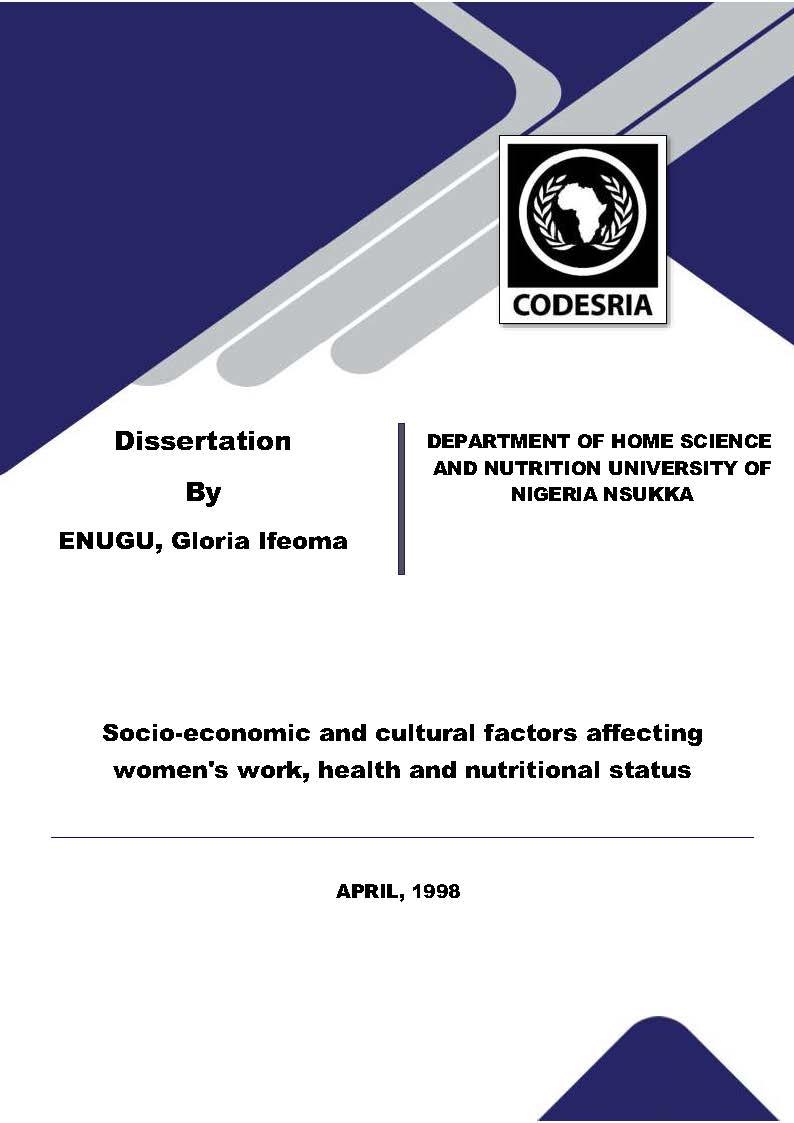Socio-economic and cultural factors affecting women's work, health and nutritional status
Keywords:
Socio-economi, health and nutritional status, Nigeria, farming communitiesSynopsis
This study .was designed to investigate the effect of socio-economic. and cultural factors could affect women's work, health and nutritional status. Two farming communities - Eha-amufu and Adani both in Enugu State, Nigeria· were selected for U1e study. A total or 300 womt:n comprising of JOO each of Cachers, farmers and pelly traders were studied. This sn1dy was carried oul
by means of focus group discussion (FGD), questionnaiw, anthropometric meawremenl, activity pattern. and, nutrient intake assessment. Educatio~ inl1uenced type of work and therefore income ol' the women. Women spent long hours al work (6.0 - 11:l hrs.) daily depending on the season of the year. Teachers met the PAO/WHO recommended requirement for protein, calcium, U1iamin, vitamin A and ascorbic. acid. Farmers met their recommended requirement for .calcium, vitamin A and ascorbic acid. Petty traders met their recommended intake for calcium and vitamin A. The BMI values for the , teachers (23.8±2.5) was higher than those of farmers (21.1 ±2.5) and petty traders (21.0 ±2.3). Hqwever, these three BMI val'.1es wert.: · not statisticall~ different. Teachers had better health seeking behaviour as indicated by the fact that majority (67.7%} of them went to the hospital for treatment of diseases compared to 4.1 % farmers and 8.3 % petty traders. The number of teachers
that went for check-up was also significantly higher (P'< 0.05) than for the
Downloads
References
Acsadi G, Acsacti GJ. (1990). Safe motherhood in South Asia:
Sociocultural· and demographic aspects of maternal health. . In:
Koblinsky M, Timyan J, Gay T (ed). The health of women: A global
perspective. Westview press, Oxford, USA 3 - 27. ·
Azizkarin S,'Midhet F ([991). Anaemia .in pregnancy: A;,continuing problem
in developing countries. In: Koblinsky M, Timyan J, Gay T (ed). The
health of women: A global perspective. West view press, Oxford, USA
- 77.
Bleiberg F, Brun TA, Goiham S, Gouba E (1980) Duration of activities and
energi exp·~nditure of female farmers in dry and rainy season in Upper
Volta. Brit. J. Nutr. 43: 71 - 80.
Chaudhury R.H. (1988). Adequacy of child dietary intake relative to that of
other family members. Food and Nutr. Bull. 10: 26 - 34.
Cousins O (1991). Women Organising. Presentation to the 18th annual
'1!' national council on international ltealth conference Arlington, Virginia,
USA. '
Didomenico C, Mojaetan L (1976). Occupational Status of women in Nigeria:
A composition of two urban centres. University of Ibadan, Nigeria. 24.
- 30.
Durning. AB (1989). Poverty and the environment: Reversing the downward
spiral. Worldwateh Institute, Washington, D.C. 3 - 16.
Economic Council for Africa (1980). Out of school education for women in
African countries. In: Koblinsky M, Timyan, J, Gay J (ec.i). The health
of. women: A global perspective. Westview press, Oxford, USA. 17 -
. 23 .
FAQ/WHO (1962). Calcium requirements. Technical report ~eries No. 230.
FAQ (1968). Food composition table for use in Africa Rome, Italy.
· FAO (1988). Vitamin A and lron requirement. Technical report series No. 23
FAQ Rome.
FAO/WHO/UNU (1985). Energy and Protein requirements Technical rep6ri
series No. 724 WHO, Geneva. ·
Gift HN, Majorie B, Washbon C, ,Harison G (1972). Nutrition b,eheaviour and
change. Prentice hall, Inc. Englewood Cliffs, New Jersey 254 - 255.
Gough J (1984). Angola Women: Building the future, organisation of Angola
women. Ruanda books, Londs.
Hamilton S, Popkin B, Spicer D (1984). Women and nutrition in third world
countries, Praeger, New York. 22 - 30.
Berio AJ (1984). The use of time allocation data in developing countries: from
influencing develbpment policies to estimating energy requirements. In:
I-lol111ho1.!-0l11.!SC11, G, Mascarenhas 0, Wandel· M ( 1988) Pond· and
Nutr Bui 10: 8 - 13.
Bhatia T (1985). Impact of training on the performance of traditional birth
attendance. J family welfare 32: 1 - 8.
' ',
Boulding E (1977). Women in the twentieth century John Wiley, New
York.
- 21
Buzina R, Bates CJ, Westenhofer J (1989) Workshop on funtional significance
of mild-to-moderate malnutrition. Am J Clin Nutr, 50. 1 - 8
Chatterjee M and Lamber J (1990). Women and nutrition: reflections ·from .
India and Pakistan. Nutrition policy discussion paper, No 6.
, 1 . Chen LC, Huq E, D'Souza SD (1981). Sex bias in the family allocation of
food. and health care in rural Bangladesh. Population development
review, 7: 55 - 70.






